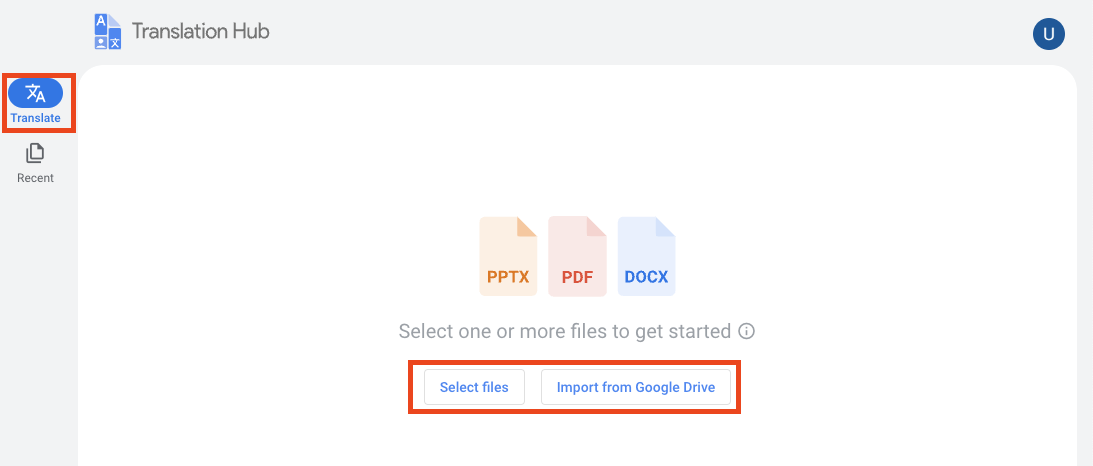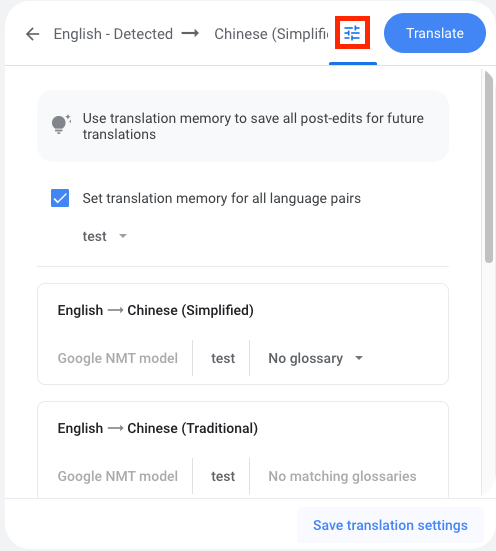After an administrator adds you to portals, you can sign in and start translating documents from any supported language to one or more of the supported languages. For supported file types, see Supported formats.
Translation Hub also has usage limits, as described in Quotas and limits. For example, there's a limit on the number of PDF pages that you can translate per file. If you have files that exceed this limit, split your files into smaller sizes to translate them.
Portal tiers
Translation Hub offers two portal tiers: basic or advanced. Depending on your portal's tier, some features might not be available to you.
Advanced-tier portals offer additional features at a different translation cost per page, such as post-editing capabilities. When administrators create a portal, they select the portal's tier, which cannot be changed later. If you must use a different tier, ask an administrator to create and add you to a portal in that tier.
To view the tier of your portal, see View portal tier.
Translation resources
Translation resources help you modify translations so that the results are tailored for your domain. Administrators manage these resources and assign them to portals to make them available for you to use.
If available, you can choose to use glossaries, translation memories, and custom models when you request a translation. The following list describes these resources and when you might use them.
Glossary: A glossary is a custom dictionary to control how specific terms are translated. Due to glossary size limits, the glossary is meant to translate small segments like domain-specific terms or entities (such as names of people or organizations). Glossaries help you fine tune terminology during the machine translation process.
Learn about glossaries.
Translation memory (advanced tier only): A translation memory controls how matching segments are translated at the sentence level.
During the post-editing process, a translation memory captures changes made by an editor as source and target language segment pairs. When you apply the same translation memory on future translations, Translation Hub applies the human-reviewed translations on exact matches.
Learn about translation memories.
Custom model (advanced tier only): A custom model is a translation model that is tuned with your sentence pairs. Compared to the general Google NMT model, a custom model helps improve machine translations for a specific domain and writing style.
Learn about custom models.
How Translation Hub applies translation resources
For each translation request, you can use one or more translation resources. If you use a combination of these resources, they work together in the following way:
- Translation Hub processes the translation memory first. For each exact match on a source language segment, Translation Hub uses the corresponding target language segment.
- For the remaining untranslated segments, Translation Hub machine translates them. Translation Hub uses the default Google NMT model unless you selected a custom model.
- On the resulting machine translation, Translation Hub uses the glossary to replace matching source language terms with their target language terms.
Request a translation
Use a translation portal to translate one or more documents from a single source language to one or more target languages. An administrator must add you to a portal before you can sign in.
Go to https://translationhub.cloud.google.com/ to sign in to a portal.
If this is your initial sign-in, you must accept the Google Cloud terms of service to continue.

If you're assigned to multiple projects or portals, choose a project and then choose any available portal within your selected project.
If you have advanced and basic-tier portals available to you, select the tier that best suits your usage. Consider whether you must use the advanced-tier features, such as post-editing. For the advanced tier, all translations are charged at the same price whether you use the advanced features or not.
From the Translate page, click Select files to upload local files or click Import from Google Drive to select files from Google Drive.

Select one or more files to upload or import.
If you select one file, Translation Hub shows a preview. If you select multiple files, Translation Hub shows a list of files to translate.
All files must be in the same source language.
Start a new translation.
If you added multiple files, select the source language of your documents. If you added one file, Translation Hub automatically detects the source language.
Click Target language to select one or more target languages.
Click Configure to select translation resources for each target language.
For glossaries and custom models, only the ones that apply to your selected target languages are available for you to use. Translation memories can apply to any source and target languages. You can specify a translation memory for each target language or use the same one for all target languages.
To save and reuse changes from post-editing, you must select a translation memory that's configured as read-write where the edits are saved. If you don't specify a translation memory, you can't select one later for this translation job.

If you want to save these settings as a translation template, click Save translation settings, and then name the template.
If you frequently use the same translation settings, creating a template can help you quickly and consistently apply the same settings each time. These templates are available only to you and not other portal users. Only administrator-created template are available to all portal users. You cannot edit templates after you create them. Instead, you must delete and recreate them.
Translation Hub limits the number of templates that you can create per portal. For more information, see Quotas and limits.
Click Translate.
Translate text in images
For scanned PDF files, Translation Hub can translate text in images, such as text labels in a diagram. Images must be oriented so that the text is also oriented in the direction appropriate for the language. For example, if an image and its text is upside down, the image is unlikely to be appropriately translated.
For other filetypes, if image translation is a priority, consider converting your source file into a scanned PDF file. Translation Hub doesn't provide this conversion, you must use a separate tool. If you have existing PDF files, you can determine whether they are scanned or native PDF files by counting the number of text characters. Translation Hub considers PDF files with 10 or more text characters as native PDF files.
View and retrieve translation results
After a machine translation is complete, you can view a side-by-side comparison of the source document next to the translated document. When you're done with your review, you can download the translated document to your local computer or export it to Google Drive.
Go to https://translationhub.cloud.google.com/ to sign in to a portal.
Click Recent to view recent translations.
The filename for a translated document is the source filename appended with the target language.
Find the translated file and click View document.
Translation Hub shows the original and translated documents side by side.
To retrieve a translated file, click Download or select More > Export to drive to export it to Google Drive.

View portal tier
Go to https://translationhub.cloud.google.com/ to sign in to a portal.
Click your profile to view information about your portal.
View the portal tier, which is shown after the portal name as either Basic or Advanced.
What's next
- Learn how to post-edit translated documents.
